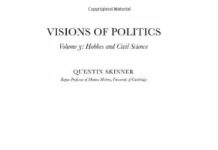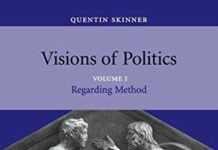
Ebook Info
- Published: 1978
- Number of pages: 330 pages
- Format: PDF
- File Size: 14.83 MB
- Authors: Quentin Skinner
Description
A two-volume study of political thought from the late thirteenth to the end of the sixteenth century, the decisive period of transition from medieval to modern political theory. The work is intended to be both an introduction to the period for students, and a presentation and justification of a particular approach to the interpretation of historical texts. Quentin Skinner gives an outline account of all the principal texts of the period, discussing in turn the chief political writings of Dante, Marsiglio, Bartolus, Machiavelli, Erasmus and more, Luther and Calvin, Bodin and the Calvinist revolutionaries. But he also examines a very large number of lesser writers in order to explain the general social and intellectual context in which these leading theorists worked. He thus presents the history not as a procession of ‘classic texts’ but are more readily intelligible. He traces by this means the gradual emergence of the vocabulary of modern political thought, and in particular the crucial concept of the State.
User’s Reviews
Editorial Reviews: Book Description A two-volume study of political thought from the late thirteenth to the end of the sixteenth century.
Reviews from Amazon users which were colected at the time this book was published on the website:
⭐I bought this book based on Skinner’s reputation and influence. There is something “seminal” about the “Cambridge school”, supposedly. After seeing one too many footnotes to Skinner in other books, I decided I nedeed to fill in the gaps.As Skinner makes clear in his preface, his three goals in writing this two volume, very expensive paperback were (a) to offer an outline of the principal texts of late medieval and early modern political thought; (b) to use texts in order to illuminate a more general historical theme, the process by which the modern concept of the State came to be formed; and (c) to exemplify a particular way of approaching the study and interpretation of historical texts that attempts to put texts in their context (a “social and intellectual matrix”), “a history centred less on the classic texts and more on the history of ideologies, my aim being to construct a general framework within which the writings of the more prominent theorists can then be situated.” When I started this book, I was most interested in (c) above, because in the abstract it seems like a difficult, but necessary project.Skinner succeeds wonderfully in accomplishing (a) but fails in (b) and (c). Skinner covers a lot of ground, describing not only the major high water marks of the intellectual development of political theory in northern Italy and beyond. He delves into analyses of texts that often get overlooked. In this respect, it is a well-done work.But Skinner plays fast and loose with both the time sequence of the ideas and events he describes and the connection between ideas and social, material, and political context of those ideas, making it difficult to understand what is really driving political thought.In chapter one, Skinner does a good job of establishing part of the situation – de facto independent city-states of the Regnum Italicum of northern Italy were caught in a power struggle between the Holy Roman Empire that claimed jurisdiction to rule over the city states as part of the Empire and the Holy See in Rome that claimed a temporal authority to rule Italy. Skinner does a good job of showing how different ideologues of the time lined up on different sides of the debates to give justification to the different options – allegiance to the Empire, allegiance to the Church, or “Liberty”, understood as autonomy of the cities of the Regnum Italicum. Bartolus of Saxoferrato (1314-57), a University-based jurist and scholar of Roman law, was, by Skinner’s account, the architect of the arguments against the Empire in favor of city-state autonomy; a long string of what Skinner calls “lawyer-popes” elaborated a complex legalistic vision of the Church as what we would now call the “secular” ruler of Italy through a long series of papal decrees; Dante, who had been exiled from Florence by the pro-Church city rulers, in 1309-13 in his book “Monarchy” argued against the Church in favor of the Empire. And Marsiglio of Padua (1275 to 1342) in his book “The Defender of Peace” (1324) according to Skinner, was a defender of the “liberty” and jurisdiction autonomy of “faithful human legislators” of each kingdom against the alleged power and authority of the Church.Skinner writes about these writers and their political ideas almost as if they were operating in an idea-world detached from the real world. When Skinner talks about putting ideas in context, he means simply relating those ideas to other ideas of other writers. He does not mean relating those ideas to the political, economic or social context in which they emerged. Skinner avoids the question of why any one set of ideas would be more persuasive for someone in the context of 14th century Italy: why would any citizen of any city-state choose to struggle for the autonomy of the city states, Empire rule or Church rule? Wars were fought over this question – so surely it is not a secondary question. Skinner’s narrative takes at face value the idea that “liberty” is self-evidently the preferred political principle around which the Italian citizens were united. Is Dante then just a deluded marginal figure? Did anyone support the Pope’s power grab? The idea that some abstract notion of “Liberty” explains why anyone would resist the Empire or the Church is not self-evident outside of Hollywood movies and other cheap narratives.Problems in Skinner’s analysis emerge once we begin Chapter two. In broad strokes Skinner tries to construct a temporal narrative, starting roughly in the middle ages and ending at the dawn of modernity. But within that large frame, he plays fast and loose with time sequence. The discussion of Bartolus, who was not even born until Dante had already written “Monarchy” comes several pages before Dante’s text is even mentioned or discussed. In Chapter 1, Skinner analyzes Marsiglio’s 1324 text in the context of the struggle for autonomy of city states against Church and Empire, proping Marsiglio up as a great defender of the Liberty of the city states. But Skinner begins Ch 2 by pointing out that the “brilliant flame of liberty throughout the Italian City Republics provide to be a sadly short-lived spectacle” because by the end of the 13th century despots had taken control of almost all the city states. This changes the significance of Marsiglio’s writings completely but Skinner attaches no importance to this: Marsiglio was not a defender of the liberty of some self-governing republics against the kings and popes – he was the defender of the authority of local dictators. Opposition to local despots – not marginal crackpot thinking – might explain why any Italian in the early 14th century would favor more power for the pope or the emperor. But these are my conclusions having gone back and reverse engineered Skinner’s narrative. Skinner does not advance this idea. The rest of the narrative continues along the same path: ideas are described in a vacuum, events, people, and texts are described out of temporal sequence and later in his narrative Skinner brings to light points that seem to change the significance of the points he made in earlier chapters.Whether I read Volume II, based on my experience with I, is an open question still. I find it shocking that this was published in two volumes, rather than one. The book is short – 304 pages if we include the index. Volume II is about the same. They could easily have been published as a single volume. The retail price of the paperback is also somewhat outrageous. Volumes I and II together will cost over $50. This is excessive, especially for the kind of text that Skinner has produced. Apparently this sort of scholarship – “contextualization of ideas within a network of ideas” is all the rage among some historians (which is why Skinner books can fetch top dollar), but it is fundamentally flawed.Overall, Skinner’s work has left me very unsatisfied. While his reputation might justify the price tag of his books, the quality of his thinking does not. Skinner is a good historian, but his achievement in this book falls short of his aspirations and he has left way too many obvious questions unanswered.
⭐Out of the religious wars between the Protestants and the Catholic Church emerged a suprisingly modern theory of individual natural rights and justified violent resistance to authority. Using ancient Roman private law concepts to justify rebellion against tyrants, Radical Calvinists such as John Ponet, Christopher Goodman, George Buchanan – all of Scotland and England, contributed, while Francois Hotman, Theodore Beza and Mornay of France transformed an essentially religious duty to resist into a secular, moral, and even natural, right of resistance.Prior to 1530, Skinner says that Lutherans and Calvinists followed a “theory of passive political obedience” and “their leaders were almost wholly unprepared to defend their Church”. Calvin thought, to oversimplify a bit, that all rulers were ordained by God, good or bad, and that man, as God’s subjects, must endure the Divine Plan. Luther restated his position in 1530 – “It is in no way proper for anyone who wants to be a Christian to stand up against the authority of his government, regardless of whether that government acts rightly or wrongly”.However, a few months later, the Catholics had outlawed the Lutherans (Diet of 1530) and then Gregory Bruck, Chancellor to John of Saxony, wrote his private-law theory of resistance “Whether it is lawful to resist a judge who is proceeding unlawfully”. Bruck took the view that “The Emperor is seeking to impose his judgement in matters of faith” where he “has absolutely no jurisdiction at all”. Then in October, as a result of a meeting at the Palace of Torgau, Luther capitulated – “until now we have taught absolutely not to resist the governing authority [because] . . . we did not know that the governing authority’s law itself grants the right of armed resistance”.Skinner says “after the immediate crisis had passed, the Lutherans not only continued to endorse the private-law theory of resistance, but even began to revise and develop it”, including Luther. Here Luther smacked counter to Calvin by stating in 1539 that “The Emperor is head of the body of the political realm”, and as such is “a private man to whom political power is granted for the defence of the realm”. The Lutherans also developed a constitutional theory of resistance in that lesser politicos are equally ordained by God and thus can outnumber an unrighteous superior, but this theory did not develop into a natural right of resistance.However, Skinner says “the basic argument in favour of resistance advanced by the Calvinists (during the late 1540s) . . . was largely a repetition of the Lutheran constitutonal theory”. He adds “When we turn, however, from the continental leaders of Calvinism to the more revolutionary protagonists of the movement in England, we find a very different situation . . . the Scots and English revolutionaries . . . began to exploit the more individualistic and radically populist implications of the private-law argument”.Ponet and Goodman abandoned “the cardinal Augustinian assumption that, even if our rulers fail to discharge the duties of their offices, they must still be regarded as powers ordained of God”. Goodman used Conciliar thinking to bring him to the conclusion that “it is lawful for the people, yea it is their duty, to do it themselves”, thereby ensuring that they “cut off every rotten member” and to impose the law of God “as well upon their own rulers and magistrates as upon others of their brethren”. Goodman thought God would punish anyone who did not carry out their duty, and armed thus, Calvinists revolted successfully from the Catholics.At this point in history, “the radical Calvinists of the 1530s have no such concept of political resistance as a right” apart from a religious duty. This thinking was later accomplished “by the Huguenots during the French religious wars in the second half of the sixteenth century”.Skinner says “Since [the Huguenots]. . . were in a considerable minority, they could scarcely hope to invoke the available Calvinist theory of revolution, and demand . . . that the whole body of the godly people should rise up against the congregation of Satan in order to establish the congregation of Christ. They needed to develop a revolutionary ideology capable of appealing . . . to the various Catholic malcontents”.The French monarchy “had rendered itself so unpopular in the first half of the sixteenth century”, that the Huguenots sought to appeal to the general discontent. The Huguenot monarchomachs (those who argued for the right and/or duty of subjects to resist unjust rulers), best exemplified by Francois Hotman’s “Franco-Gallia”(1573), concentrated on grounding their arguments on real or presumed historical precedents in French laws and institutions resulting in a rather narrowly legal and historical argument. Their conclusions and implications were limited to promoting specific liberties of various privileged orders in French society.Skinner says “The essence of the Huguenot case is thus that the magistrates and representatives of the people have the moral right to resist tyrannical government by force, a right which is founded on the prior and natural right of the sovereign people to treat the commonwealth as a means for securing and improving their own welfare”. He concludes that “with Beza, Mornay and their followers, the idea that the preservation of religious uniformity constitutes the sole possible grounds for legitimate resistance is finally abandoned. The result is a fully political theory of revolution, founded on a recognisably modern, secularised thesis about the natural rights and original sovereignty of the people”.In summary, Skinners says that Radical Calvinism developed a secular, moral, and natural right of resistance. Yet it seems to me that they did so grudgingly and never really fully grasped natural law or natural rights. J.W. Allen noted in his “A History of Political Thought in the Sixteenth Century”, p314, that the language of universal natural rights “served no Huguenot purpose. It served, in truth, no purpose at all at the time, though, one day, it might come to do so”.
⭐terrible shape
Keywords
Free Download The Foundations of Modern Political Thought, Vol. 1: The Renaissance in PDF format
The Foundations of Modern Political Thought, Vol. 1: The Renaissance PDF Free Download
Download The Foundations of Modern Political Thought, Vol. 1: The Renaissance 1978 PDF Free
The Foundations of Modern Political Thought, Vol. 1: The Renaissance 1978 PDF Free Download
Download The Foundations of Modern Political Thought, Vol. 1: The Renaissance PDF
Free Download Ebook The Foundations of Modern Political Thought, Vol. 1: The Renaissance




